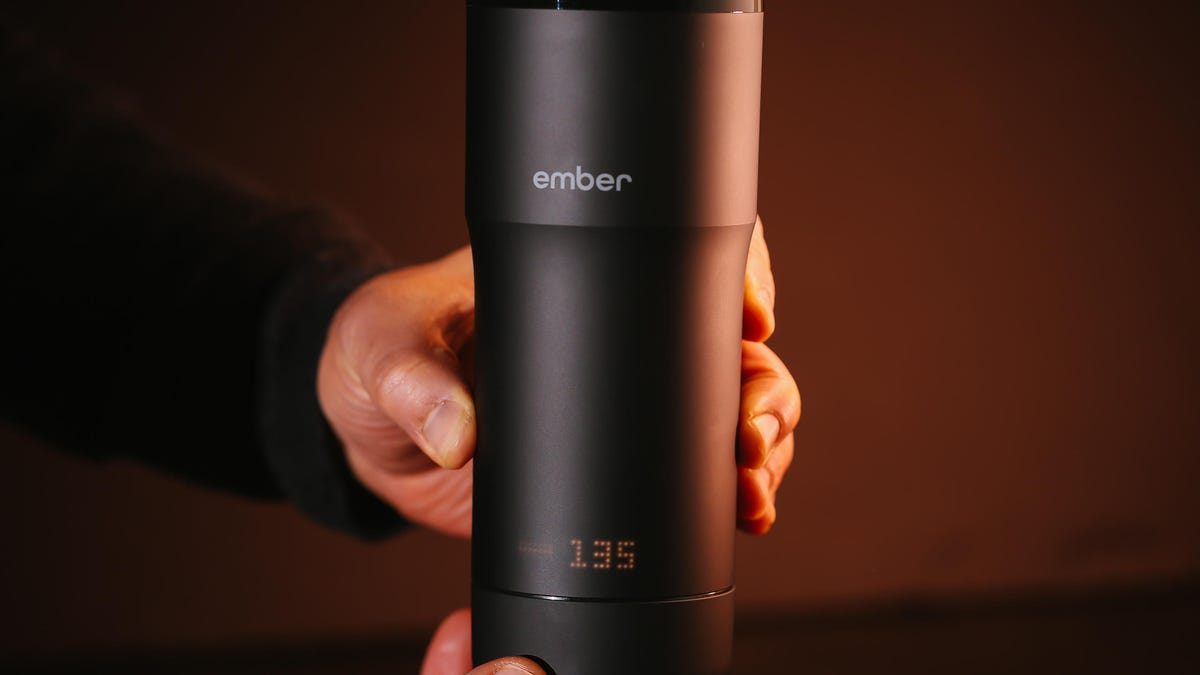 Why You Can Trust CNET
Why You Can Trust CNET I fell in love with the Ember smart mug, and you could, too
Commentary: Don't @ me.

I fell in love with the Ember Travel Mug. There, I said it. A few months ago the startup behind this $150 travel mug sent me one to review. I strongly believed that it was a colossal waste of money. I still do. I've since packed up and returned the fancy cup to its maker. To my embarrassment I miss it, a lot.
Ember is yet another technology startup promising to reinvent something ordinary into a product we can't live without. In this case it's the humble coffee mug. Ember's revamped cups -- there are ceramic ($80) and travel versions -- use a system of sensors, a heating element and Bluetooth connectivity to maintain drinks at the perfect temperature. The fundamental idea behind the Ember is that each drink has a different and specific heat level for maximum enjoyment.
I found I couldn't stop using the Ember mug. A few times I forgot it at the CNET Smart Home, at which point I hounded my coworkers still on site to bring it back on their return to the office. Worse, I've considered buying one. There's no chance in hell it would get spousal approval, so it was never a realistic option, but it underlines that this is almost the perfect "thing I would never buy for myself, but would love to receive as a gift."
The Ember Travel Mug keeps hot beverages at exact temperatures.
How can a computerized cup feel so necessary? After a month or so of using the Ember, I noticed a disturbing trend. When given the choice between the Ember Travel Mug and an ordinary ceramic cup, I always went with the Ember. It happened even when I already own the fancy Zojirushi Travel Mug.
It turns out the appeal is simply down to temperature and taste. Hot coffee has an ideal heat level to deliver maximum flavor. To my taste buds, that Goldilocks zone ranges between 130 and 132 degrees Fahrenheit (54.4 to 55.6 degrees Celsius).
I can taste deeper, richer flavors at the right temperature, and thanks to Ember's automated heating system, my coffee always stayed parked at my favorite temp. Perhaps the best aspect, burning my mouth had become a distant memory.
Addictive, not practical
I may have become too attached to the Ember mug, but I still recognize that it's far from convenient. Outside of its high price, using the Ember requires plenty of patience.
It takes about 40 minutes for hot coffee inside to properly cool down after brewing. The cup has maximum battery life of 2 hours, but in my experience it's more like 1 hour of active heating. That means I had about 20 minutes to drink the coffee before it lost temp. That or I could drink from it while it's plugged in.
I found the Ember's companion app a useless distraction, too. I had no desire to adjust the mug's temperature through my phone. Picking up the cup and doing that manually was infinitely easier.
Smart cups for real coffee nerds
The $150 Ember Travel Mug and $80 ceramic sibling might be expensive and far from convenient. Still, what better coffee nerd badge of honor than a cup that controls its own temperature?
In my experience the Ember does, in fact, make coffee taste better -- provided you brew it right. Chances are if you're considering an Ember that's not an issue. And fervent Java fanatics aren't known for being frugal. Many won't think twice about spending $1,000 on a powerful home espresso machine. The same is true for a quality coffee grinder. So paying $150 for a fancy mug? Not a deterrent.
And the temperature controlled temptations will likely grow. Other companies are eager to enter this space and cash in. One example is Cauldryn, which sells the $150 Fyre V2 bottle. Also battery-powered, the Fyre V2 controls its internal temperature, and actually has the power to boil water, a trick the Ember can't pull off. The Fyre is supposed to work with both Alexa and Google Assistant as well. Because of course.
You can buy Ember mugs now through mega retailers, too. That list includes Starbucks, Amazon and Best Buy That's partly why I believe I won't be alone in trying to resist the siren song of heat controlled smart mugs. Sure, the price of these gadgets is a barrier to mass appeal, but the plebs know nothing. Once the true coffee geek clique catches wind of the Ember and similar products (if they haven't already), all bets are off. I just hope there are enough well-heeled coffee geeks at large to eventually bring prices down for everyone else.

